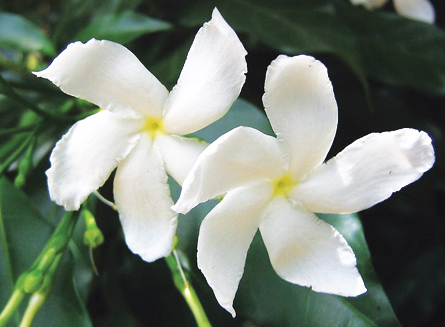- More than 2 years ago
Chemists have synthesized in the lab a pain-relieving extract from the bark of a tropical shrub, paving the way for new drugs that lack the unwanted side effects of many opiate-based pain meds.

There were hints that the compound, called conolidine, might be an effective pain medication, but studying the stuff has been tough. Isolating conolidine from the bark of the crepe jasmine plant returns pathetically meager yields, and the compound’s particular ringed structure has made lab synthesis difficult. Now researchers have overcome those difficulties and constructed conolidine in the lab from a cheap and readily available chemical building block. The molecular Tinkertoy-like construction is accomplished in just nine steps and yields large quantities of the compound, researchers report online May 23 in Nature Chemistry.
Extracts from crepe jasmine, Tabernaemontana divaricata, have long been used in traditional medicine, but how this particular compound alleviates pain remains a puzzle. Despite its name, the plant isn’t closely related to scented jasmine. Instead it comes from a plant family rich in alkaloids, compounds that are often poisonous but have been commandeered as medicine for treating malaria, cancer and other maladies.
Various tests designed to elucidate where and how conolidine does its stuff in mice suggest that the compound doesn’t hit the same cellular machinery as the classic pain-relieving alkaloids codeine and morphine. Yet conolidine does lessen both acute pain and pain from inflammation, the team from Scripps Research Institute’s campus in Jupiter, Fla., reports. The compound might be hitting one unknown cellular target or perhaps several, says organic chemist Glenn Micalizio, a coauthor of the new work.
Figuring out conolidine’s mode of action may take some time, says McGill University’s Laura Stone, a neuroscientist who specializes in pain. But the new data suggest that conolidine won’t bring about the same side effects as opiates, such as depressed breathing and addiction.
“That doesn’t mean it won’t have its own set of side effects,” she cautions, “but those tests are definitely worth doing.”
Such tests are possible now that greater quantities of conolidine can be made, says natural-products chemist David Kingston of Virginia Tech. Some plant-derived compounds are incredibly unruly to isolate and synthesize. It took more than a decade for researchers to figure out how to make reasonable quantities of the cancer-fighting drug taxol, for example, an extract of the bark of the Pacific yew tree. Two tricks are now used to make the drug in large quantities: Researchers either coax plant cells to grow the stuff in the lab or extract a similar, much more plentiful compound from yew tree needles and then add an extra chemical arm to get taxol.
The mere nine steps needed to get conolidine in the lab suggest that such strategies may be unnecessary, says Kingston.
“What we love to find is a relatively simple structure that we can synthesize easily,” says Kingston. “Those are rare.”






